Florida Trees and Shrubs
Roundpod St. John's-Wort, Coastalplain St. John's-wort, Peelbark St. John's-wort, Four-petal St. Johns Wort, Florida Boxwood, White Lantana, Pineland Croton, Pineland Strongbark, Two-leaf Nightshade, Castor bean
Roundpod St. John's-Wort - Hypericum cistifolium
Family - Clusiaceae
Native
_small.jpg)
Habitat - Wet Pinelands, Bogs, Marshes, Margins of swamps
Description - This shrub is one of about 29 Florida native Hypericum species. 2 - 3 feet tall with branched terminal clusters of yellow flowers produced year-round. Dark green shiny lanceolate leaves.
Sandweed, Peelbark St. John's-wort - Hypericum fasciculatum
Family - Clusiaceae
Native

Habitat - Pineland depression marshes, Wet Prairies, Swamp margins.
Description - Native shrub, 4 foot average height, leaves linear to almost needle form with rolled under edges. Yellow 5 petal flowers with many stamens, flower petals forming a pinwheel shape. Blooms year-round.
Four-petal St. Johns Wort - Hypericum tetrapetalum
Family - Clusiaceae
Native


Habitat - Wet Pinelands
Description - Native. Evergreen shrub to 3 feet tall, with narrow growth form. Leaves are opposite, ovate, clasping, heart-shaped at base.
Flower - Yellow, four petals, 3 cm. across with numerous stamens.
Florida Boxwood - Schaefferia frutescens
Family - Celastraceae
Native
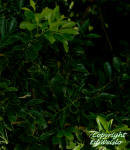
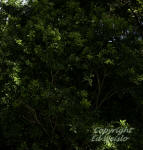
This Florida native grows as a small tree or multi-stemmed shrub to 20 feet. The bark is light brown and smooth, becoming gray and furrowed with age. Leaves are elliptical to obovate, alternate, 2 -3 inches long and are light green in color. Flowers are small, light yellowish green in color and are produced in clusters at the leaf axils.
Endangered within the state of Florida, this tree is also is found throughout parts of the Caribbean and South America.
Button Sage - Lantana involucrata
Family - Verbenaceae
Native
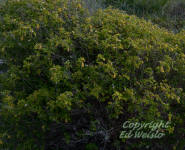
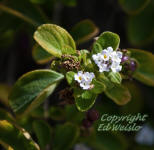

This native Lantana is primarily found growing near the coast at the margins of Hammocks, behind the dune line and in the Pine Rocklands habitat of extreme S. Florida.
Leaves are pale green, opposite, simple, oval with slightly crenate or toothed margins, covered with small hairs, rough to the touch, less than 1 1/2 inches in length. Leaves have a sage like smell when crushed. Plant is 7 feet or less in height with anopen habit of growth and thin stems.
Flowers are produced year-round in clusters and are white, often with a lavender or or pale bluish tint. Fruit is a small purple drupe. Button sage is a nectar plant for many butterflies.
Pineland Croton - Croton linearis
Family - Euphorbiaceae
Native
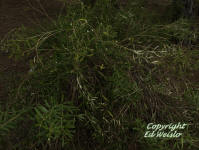
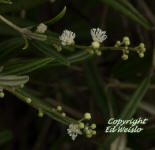
Limited to the southern most part of Florida and the Florida Keys, Pineland Croton is a clump forming, many stemmed, sprawling shrub.
Growing to about 6 feet tall, Pineland Croton is found primarily in Pine Rockland habitat, it has also been found in Palm beach, Martin and St. Lucie counties.
Habit of growth is as a thin stemmed sprawling shrub. Leaves are alternate, simple with entire margins, linear, dark green above and silvery on the bottom, 3-4 inches long. Flowers are small, white and are produced year-round on racemes.
Pineland Strongbark - Bourreria cassinifolia
Family - Boraginaceae
Native

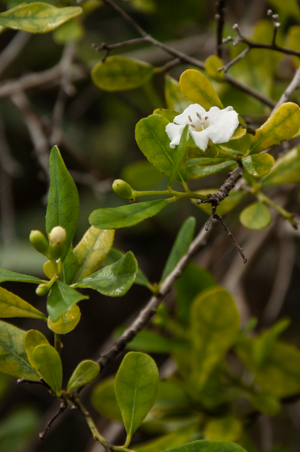
Rare native shrub limited to Monroe and Miami-Dade counties in Pine rockland habitat, grows to 10 feet or less in height, usually with many stems.
Leaves are alternate, variable, elliptical to ovate with entire margins. Flowers are white, tubular with five petals followed by an orange fruit.
Two-leafed Nightshade - Solanum diphyllum
Family - Solanaceae
Exotic / Invasive
%20detail%20_small.jpg)
%20_small.jpg)
Habitat - Ruderal, escapes from cultivation. Rare
Description - Category 2 exotic plant. Up to 6 feet in height, leaves in pairs with 1 leaf larger, deep green, smooth, 1-3 inches long
Flower - Clusters of white flowers with yellow antlers - similar to the Black Nightshade plant, fruit is a 1/2 inch round, hard berry, yellow to orange in color.
Castor bean - Ricinus communis
Family - Euphorbiaceae
Exotic / Invasive



Habitat - Disturbed areas
Description - Introduced non-native plant, Castor bean has been cultivated for thousands of years and is believed to have originated in tropical Africa. Grows as a shrub or small tree and may be an annual or perennial depending on the local climate. the Castor bean plant is capable of attaining a height of 40+ feet in a tropical climate though it's more common in the 10 - 20 foot range in much of South Florida.
Large palmate leaves to nearly 24 inches wide with 6 or more lobes, margins toothed. Stems are herbaceous except on larger specimens the base of the main stem may become woody. The leaves & stems of Castor bean may be green, red or purple. Flowers are produced on an inflorescence in warm months followed by spiny capsules containing the seeds. All parts of the castor bean plant are poisonous, with the seeds being the most toxic.
%20_small.jpg)